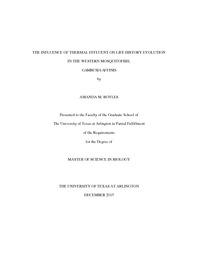| dc.description.abstract | The evolutionary consequence of heated effluent on the Western mosquitofish, Gambusia affinis, was studied at Lake Fairfield, in Freestone County, Texas. The Lake Fairfield reservoir receives heated effluent from Luminant’s Big Brown Power Station. Heated effluent from the power station is discharged into a ‘hot pond’ reservoir before it is allowed to return after cooling to the main reservoir, or ‘main lake’ of Lake Fairfield. Heated effluent elevates the temperature of the hot pond throughout the year and the elevation in water temperature has selected various life history traits in G. affinis that are divergent from the main lake G. affinis population, such as growth rate, clutch size, reproductive allotment, lipid content, and size at maturity. This work builds upon previous research demonstrating evidence for genetic divergence between the two populations of G. affinis residing in the heated and non-heated regions in Lake Fairfield, and takes the logical next step by exploring these same populations for genetic shifts in life history traits that are directly connected to rates of population growth. This was accomplished by examining patterns of phenotypic life history variation (phenotypic assays) in preserved specimens collected monthly over the course of a year, by performing two sets of reciprocal transplant experiments, and a complimentary common garden experiment. The assessment of phenotypic variation between sites revealed that G. affinis in the hot pond exhibit smaller clutch sizes, smaller reproductive allotment, larger lipid stores, and larger male maturation sizes than G. affinis in the main lake. The results of two independent reciprocal transplant experiments as well as a common garden experiment provide evidence for locally adapted differences as mosquitofish fish from the main lake exhibited faster rates of growth than fish from the hot pond and such differences were generally larger when all populations were reared in the main lake. The assessment of environmental parameters between the hot pond and main lake showed that water temperature was consistently higher in the hot pond and that potentially covarying factors, such as dissolved oxygen, conductivity, salinity, and pH, did not differ between the divergent environments. The observed life history differences between the hot pond and main lake are therefore best explained as driven by elevated water temperature due to the release of heated effluent. Given that the Big Brown Power Station commenced operation in 1971 and has been continuously operating since that time, our results substantiate that human driven alteration to thermal regimes can drive significant evolutionary changes within 44 years. This study provides information on the extent to which species can rapidly adapt to increased environmental temperatures in the form of artificial heating and alter the expression of life history traits when isolated in environments that receive heated effluent. The results of this study also represent an important step in the integration of evolutionary biology and conservation science, and offer information to be considered when adopting management plans for conserving aquatic communities. | |

